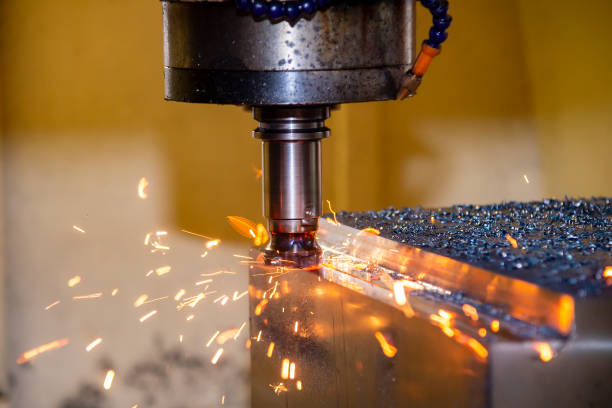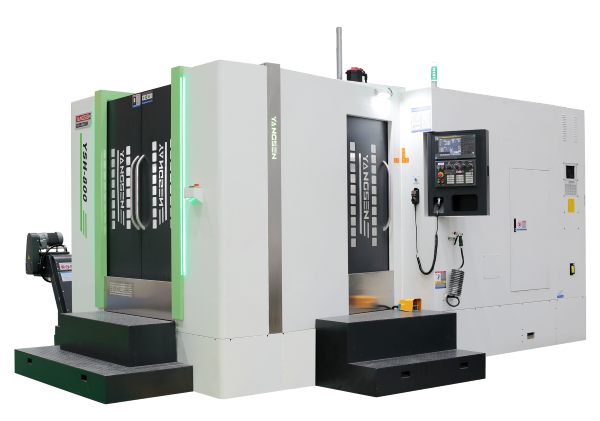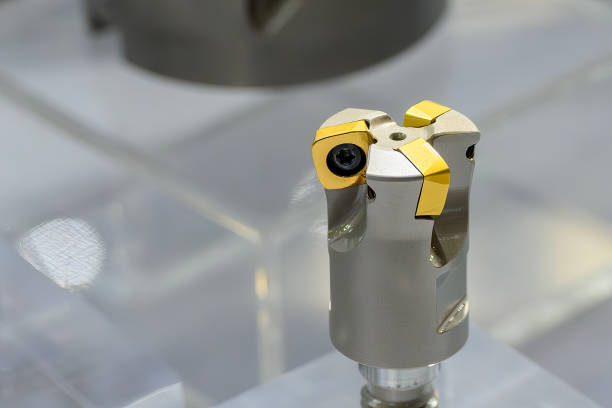Milling is a type of cutting process used to produce various mechanical parts made of resin or metal. Using a variety of different tools during the machining process, complex shapes can be machined. It is also a processing method with high surface processing accuracy.
Milling is a processing method that rotates a cutting tool at high speed to cut a workpiece fixed on the workbench. Cylindrical cutting tools are collectively called milling cutters. Mainly used for processing gears, molds, mechanical parts, etc. Using different types of cutting tools, various shapes such as planes, curved surfaces, holes, slots, etc. can be processed. Generally, the cutting tool moves up and down, while the workbench holding the workpiece moves forward, left, and right to complete the processing process. Although the tool and worktable can move in 3D space and can process complex shapes, it must be noted that depending on the machine tool, some shapes can be processed and some shapes cannot. . A milling machine with the tool spindle perpendicular to the worktable is called a vertical milling machine and is the most common type of milling machine. A milling machine with the spindle parallel to the worktable is called a horizontal milling machine.

There are many types of machine tools used in milling operations. The following introduces the characteristics of the main machine tools used for milling processing.
A general-purpose milling machine refers to a milling machine in which the operator manually installs cutting tools and operates the processing. The quality of the machined workpiece depends on the experience and skills of the operator. If skilled workers perform processing, they can make fine adjustments to the machine tool to achieve high-precision, high-quality processing results. Therefore, the machine is suitable for processing prototypes with complex shapes or high-precision one-off orders. The general-purpose milling machine was a machine tool mainly used from the 1820s to the early days of rapid economic growth. It can be said to be the basic equipment for mechanical processing.
CNC milling machine refers to a milling machine that uses a computer to process by numerically controlling processing conditions. Numerical control (NC) is the abbreviation of NUMERICAL CONTROL. The disadvantage of general-purpose milling machines is that the quality of the workpiece processed varies from operator to operator. Therefore, the purpose of developing CNC milling machines is to reduce the difference in quality of processed workpieces. General milling machines require manual adjustments at every stage of the processing process, while CNC milling machines can be controlled numerically, improving the accuracy and quality of processing.

A machining center is a machine tool that can not only adjust processing conditions through a CNC system like a CNC machine tool, but also automatically change tools. Previously only one type of tool could be installed, but now multiple tools can be installed at the same time. Tools can be changed automatically, eliminating the need for manual operations, thereby increasing efficiency. CNC technology is still developing, making complex high-precision machining possible.
CNC gear processing machine tool is a milling machine tool used for gear processing. Machining is performed by rotating a specialized cutting tool called a "hob". Gears have complex shapes and are very precise parts. There are many types of gears, such as spur gears, helical gears, and worm gears. CNC gear processing machine tools can easily adjust parameters such as the number of teeth and automatically perform gear hobbing.
Milling requires the use of different tools depending on the shape you want to machine. The characteristics of four representative milling cutters are introduced below.
Plane milling cutters are also called "face milling cutters". They have multiple cutting edges attached to the outer circumference of a circle and process the shape surface by rotating and moving the cutter in parallel. Due to the large cutting area at one time, the cutting efficiency is very high. It can perform high-precision surface processing. It is primarily used on vertical milling machines and is the most commonly used tool type.
Plane milling cutters are also called "face milling cutters". They have multiple cutting edges attached to the outer circumference of a circle and process the shape surface by rotating and moving the cutter in parallel.

An end mill is shaped like a drill bit and is elongated. It is a multi-functional tool that can be used for processing various shapes, including flat processing, step surface processing, groove processing, etc. In addition to flat-end mills with square tips, there are also ball-end mills suitable for curved surface machining. Face mills can machine large flat surfaces, while end mills can machine smaller, finer shapes. In addition, it can process not only flat surfaces but also various shapes, thereby reducing the time required for tool changes. The number of blades is generally 2 to 4, which can be selected according to the purpose and the size of the workpiece.
Like high-speed milling cutters, slot milling cutters use a round rod-shaped tool to rotate and move in parallel to cut the groove shape. The width and outer diameter of the blade determine to some extent the width and depth of the groove. The cutting speed is faster than grooving with an end mill, and the machining accuracy is higher. This tool is particularly useful for machining many long, deep grooves.
A flat milling cutter refers to a cylindrical milling cutter with teeth distributed on the circumference of the milling cutter. Installed on horizontal milling machines for surface processing. Flat milling cutters are more efficient but less precise than face milling cutters. Therefore, it is mainly used for rough machining.
Milling processing can process different geometric shapes by using different types of tools. The following is an introduction to representative processing types.
Flat machining refers to cutting a flat feature on the workpiece. The workbench that fixes the workpiece can move forward, backward, and left to complete the cutting process of the workpiece. Surface machining is mainly done using face milling cutters or flat milling cutters. Generally speaking, different machine tools use different cutting tools. Face milling cutters are used in vertical milling machines, while flat milling cutters are used in horizontal milling machines. Although end mills can also be used for surface machining, they are not suitable for machining larger areas and can usually be used for machining smaller surfaces.
Side machining refers to cutting the side of the workpiece by moving the tool up and down. As with surface machining, it is generally achieved with a face milling cutter or an end milling cutter. In addition, a side milling cutter can also be installed on a horizontal milling machine to cut the side, which is mainly used for rough machining.
Step surface processing refers to cutting the flat surface and side surface at the same time to form a step shape. Cut an additional step down from the plane machined with a face mill or flat mill. Face mills are used to machine wide surfaces and low-step shapes, while end mills are used to machine narrow surfaces and high-step shapes.
Keyway processing is the process of grooving the workpiece. The most common method is with an end mill, but in some cases slot mills are also used. The end mill moves to the designated position and the worktable is moved for grooving. A tool called a T-slot cutter can also be used to machine slots with a wider base. Parts such as mounting bolts have the shape of a T-slot.
Holes can also be made like a drill press. First drill the bottom hole with a center hole drill, and then machine it to the specified depth through the cutting edge. In addition, end mills can also be used for hole machining. End mills are usually used for hole machining that requires positional accuracy with the surface. Because surfaces and holes can be machined without changing tools, it is easier to ensure positional accuracy.
The basic principle of machining is to move the tool up and down and the workpiece front and back, left and right, but by using a CNC system to simultaneously control and move the tool and worktable, three-dimensional shapes can also be processed. This kind of processing is called "three-axis simultaneous processing".
Milling is a type of cutting process that is performed using a processing machine tool called a milling machine. Milling processing machine tools include manually operated general milling machines, as well as automatically controlled CNC milling machines and machining centers. In the milling process, tools must be selected according to the purpose, such as face mills (face mills), end mills, slot mills and flat mills. These tools combine to machine flat surfaces, curved surfaces, side surfaces, and geometries such as stepped surfaces, slots, and holes.